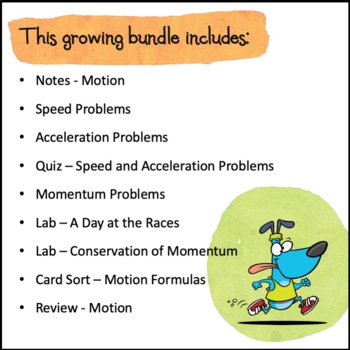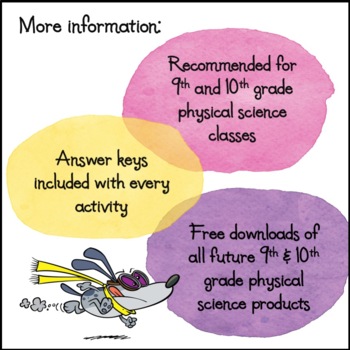Bundle of Lessons - Motion - Speed, Acceleration, and Momentum
- Zip
- Easel Activity
What educators are saying
Products in this Bundle (9)
showing 1-5 of 9 products
Bonus
Description
This bundle of lessons will prepare students to describe and calculate speed, velocity, acceleration, and momentum using worksheets, lab activities, a card sort, and review. 9th and 10th grade physical science students will solve problems using variables including distance, time, and mass. Other topics include frame of reference, motion, deceleration, and centripetal force.
Important Information
- Do not allow students to use calculators or they will finish these activities too quickly. This is an opportunity for them to apply their basic math skills.
- Answer keys included
- Recommended for 9th and 10th grade science, physical science, and conceptual physics
Included in this bundle – click to see details
- Motion Notes – Speed, Velocity, Acceleration, and Momentum
- Speed Problems Worksheet
- Acceleration Problems Worksheet
- Momentum Problems Worksheet
- Lab Activity – Speed – A Day at the Races
- Lab Activity – Conservation of Momentum
- Card Sort Activity – Motion Formulas
- Review – Worksheet
TEKS Covered
8.6A
I.4A
I.4E
NGSS Standards Covered
MS- PS2-1
MS- PS2-3
HS-PS2-1
HS-PS2-3
Also found in this money saving bundle
Related Resources
Terms of Use – copyright ©Catherine Skye All rights to this product are reserved by author. This authorizes one teacher to use this product. If you want to share it with other teachers, please purchase a license to share this work. Copying by more than one teacher, classroom, department, school, or school system is prohibited UNLESS you purchase a license. Clipart and elements found in this PDF and others on my site are from the public domain unless otherwise noted. All products on my site are intended for classroom and personal use and may not be digitally copied for reuse in any form. Any misuse is considered copyright infringement and violates the DMCA (Digital Millennium Copyright Act).





